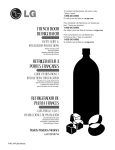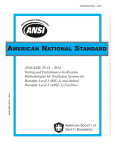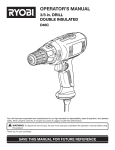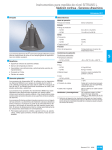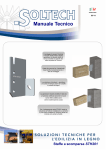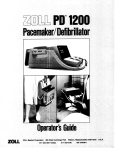Download Battery Compatibility with Photovoltaic Charge
Transcript
e JAN 0 6 1993 SAND--92-2501c DE93 005373 BATTERY COMPATIBILITY WITH,&.,,< .,. .-.,-a__.-~__~ __~_ _.,_..--_. _._I =. i~-~--.-~~~PHOTOVOLTAIC CHARGE CONTROLLERS Steve R. Harrington Ktech Corporation for: Photovoltaic Systems Research, Department 62 18 Sandia National Laboratories Albuquerque, New Mexico 871855800 Ward I. Bower Photovoltaic Systems Research, Department 62 18 Sandia National Laboratories Albuquerque, New Mexico 871855800 Abstract Photovoltaic (PV) systems offer a cost-effective solution to provide electrical power for a wide variety of applications, with battery performance playing a major role in their success. This paper presents some of the results of an industry meeting regarding battery specifications and ratings that photovoitaic system designers require, but do not typically have available to them. Communications between the PV industry and the battery industry regarding appropriate specifications have been uncoordinated and poor in the past. This paper also discusses the effort under way involving the PV industry and battery manufacturers, and provides a working draft of specifications to develop and outline the information soreiy needed on batteries. The development of thii information is referred to as *‘Application Notes for Batteries in Photovoltaic Systems.” The content of these “notes” has been compiled from various sources, including the input from the results of a survey on battery use in the photovokaic industry. Only lead-acid batteries are discussed. Introduction Battery performance is paramount to the successof a PV system’s ability to reliably supply electrical power to the load. Often these systemsare in remote areas where minimal maintenance is desirable and a logistical requirement. The electrical energy generated by the PV (solar cell) is used by the load, and/or stored in the battery(ies) for later use at night or during days of low solar insolation. The battery capacity is typically sized to provide several days (1 to 14 or more) of power to the load without solar recharging. Flooded (wet), gelled, and absorbed glass mat (AGM or starved) electrolyte batteries are presently in use in photovoltaic systems. Gel1 and AGM (both sealed)batteries consist of 56% of the market, primarily due to their extremely low maintenancerequirements if treated properly. A paper presented at this conference titled “PV-Battery Applications Survey Results” (l), provides information regarding the photovoltaic battery market. Additional information regarding the technical design and typical use of lead-acid batteries in PV systems was acquired in the survey was instrumental in developing the specifications described herein. DISCLAIMER Portions of this document may be illegible electronic image products. images are produced from the best available original document. Battery performance in PV systems is very inconsistent, typically showing a premature loss of available capacity due to undercharging or excessiveovercharging without water replacement (due to unpredictability). This results in cycle lifetimes less than those the designer originally quoted from specifications. Most specifications for batteries come from standardsfor motive and industrial use, complied by the Battery Council International @X)(2). These standardsprovide a wealth of information for motive and industrial battery users, but lack information regarding the use of sealed batteries. Also, history of PV system battery performance has shown the data for flooded batteries does not dependably apply to PV system application environments. Commendable efforts have been made by the IEEE Standards Coordinating Committee 21, Photovoltaics, in publishing the “IEEE RecommendedPractices for Installation and Maintenance of Lead-Acid Batteries for Photovoltaic (PV) Systems,“ ANSI/IEEE 937 (3). Standard 937 provides a large source of documentation regarding the safety, installation, and maintenance of flooded batteries, but falls short of what is needed by the PV system designer providing battery specifications and information on flooded and sealedbatteries. The work discussedin this paper will hopefully be integrated into this document, not to dictate philosophies of design, but to establish typical operating parameter specification requirements in PV systems. In an effort to diagnose the problems PV systems have with battery performance, tests of PV/battery charge controllers began in 1990 at Sandia National Laboratories (SNL) and the Florida Solar Energy Center (FSEC). The charge controller (battery voltage regulator) testing evolved into three phases. Phase One (4,S) was an initial evaluation of the state-of-the-art in PV charge controllers. Various charge controller regulation methods (algorithms) were examined at the same regulation setpoints. Algorithm variations while charging and discharging identical flooded leadantimony batteries allowed for a side-by-side comparison of controller performance and its effect on the battery. Phase Two (6) began after the results and trends of the first year of Phase One operation became evident. PhaseTwo included several of the samecharge controllers from Phase One that performed well, others from Phase One with adjustementsof the regulation parameters away from the traditional values, as well as two new charge controllers with different algorithms (multi-step, on/off type). Phase Three is the result of continued requests from the PV industry regarding the performance of sealed (gel1 & AGM) batteries due to their low maintenance requirements. This testing will initially consist of laboratory analysis (at SNL, FSEC, and battery mfg.) of the various regulation methods (constant voltage, pulse width modulation, and on/off) on gel1 batteries. The goal is to ascertain the optimum regulation parameters that will return the battery to full charge after the previous day’s discharge, without overcharging the sealedbatteries using PV-type charging methods. Additional efforts, such as improved designs of PV/battery charge controllers, are being included in the Photovoltaics Balance-of-SystemDevelopment Program, initiated in September, 1992at SNL. DISCLAIMER This report was prepared as an account of work sponsoredby an agency of the United States Government. Neither the United States Government nor any agency thereof, nor any of their employees, makes any warranty,’ express or implied, or assumesany legal liability or responsibility for the accuracy, completeness,or usefulnessof any information, apparatus, product, or process disclosed, or represents that its use would not infringe privately owned rights. Reference herein to any specific commercial product, process,or service by trade name, trademark, manufacturer, or otherwise does not necessarily constitute or imply its endorsement, recommendation, or favoring by the United States Government or any agency thereof. The views and opinions of authors expressed herein do not necessarily state or reflect those of the United States Government or any agency thereof. Communications With The PhotovoItaic And Batterv Industri~ The results of the SNL/FSEC testing, along with evaluations of systems in the field, and input from the PV industry, has reinforced the need for a more unified approach to applying batteries in PV systems. A meeting was held in February at the Soltech ‘92 Conference, Albuquerque, NM, between several representatives from system integrator houses (PV system designers/installers), PV balance-of-system (BOS) manufacturers (charge controllers), battery manufacturers, and various research organizations. Below are some excerpts from the minutes of the meeting (ll), providing some direct responsefrom the PV and battery industry. The obiectives of the Soltech ‘92 batterv meeting were to; 0 Verify the perception that optimizing battery life and predicting battery life/performance is one of the primary difficulties and challenges in stand-alonePV applications. 0 Obtain industry (PV) input in defining what type of efforts are needed regarding battery charge controllers and batteries. 0 Solicit industry input regarding information and/or tools needed to solve problems. Some comments from the Soltech ‘92 meeting: attendees: 0 A matrix of PV system variables versus application is needed. 0 A handbook, or user’s guide, for batteries as used in PV systems is sorely needed. 0 An applications guide that defines proper battery tests, and effects of various climates is needed. 0 Information regarding charge rates, battery state-of-charge, and water loss is needed. 0 There is a lack of hard data from battery manufacturersand no practical tests to characterize generic batteries. 0 Load and charge profiles are neededto characterize battery performance. 0 Interface between the PV systems designer and battery vendor/manufacturer is needed. 0 Dialogue is very important. Questions are difficult to define. 0 Need to standardize the questions that we ask manufacturers. 0 If the PV industry can define the right questions, then the battery people can probably provide the answers. Action Items For The Photovoltaic And Batterv Industrieq The information above indicates the PV industry feels it is lacking information regarding the proper application of batteries in PV systems, but has some idea as to what is needed to resolve its problems. There is also a clear indication of the willingness of individuals in the battery and PV industry to resolve the issues, with near-term solutions possible. As a result of the Soltech ‘92 meeting, an advisory group of volunteers from the PV and battery industry was formed. Sandia (as part of the Balance-of-Systems Development Program), will provide the necessaryeffort and interfacing to help these ideas become reality. The following is a list of action items presently envisaged as a path to resolve these issues. 1 Establish routine communication between the PV and battery industry, through written or verbal interaction. Meet with battery manufacturers and ensure a thorough knowledge of PV systems is presented, or text is available to them for review. 3 2 Produce a matrix of PV applications, listing system operating variables and requirements. 3 Standardize questions to be answered regarding battery specifications. Assemble the information in the form of a request for “Application Notes for Batteries in Photovoltaic Systems.* 4 Provide the listing of questions of “Application Notes for Batteries in Photovoltaic Systems.” Sandia will provide as much assistanceas possible to ensure these become a reality. 5 Develop the PV systemsapplication matrix and present it to battery manufacturers, to help them recommend appropriate batteries in their product line for specific applications. 6 Interface with the IEEE SCC21 (photovoltaics) and provide input to the adoption of these battery specifications and operating guidelines, and establishPV-relative charge/dischargerating standards. Working Draft of “ADDkation Notes for Batteries in Photovoltaic Svstend’&ecifications~ The following is a working draft of information considered to be important to PV system designers and installers: 1 Nominal Battery Voltage. 2 Physical Characteristics; Dimensions, Terminal types and sixes available, weight-packagedand unpackaged,wet and dry. 3 Warranty (and warranty restrictions) for use in PV systems. 4 Shipping Hazard codes. 5 Allowed and preferred orientation (e.g., upside down). 6 Series/parallei configuration recommendations,maximum configurations recommended. 7 Maximum shelf life and recommendedrecharge cycle, and recharge instructions. Self-discharge rate vs. lifetime (age), vs. temperature (graph?). 8 Available bone dry or drained and shipped? Expectedshelf life. Recommendedoptimum conditions for maximum shelf life? 9 Maximum system voltage to ground. 10 Specific Gravity the battery is normally shipped with, and are other specific gravities available. When and how should specific gravity be adjusted. 11 Electrolyte freezing temperature vs. state of charge and the effects on cycle life and capacity. 12 Maximum battery operating temperatures,and the effects on cycle life and capacity. 13 Battery plate construction (flat, tubular) and additives (% of antimony, R of Calcium, % of other), thickness of positive (or # of tubes) and negative plates, number of pas and neg plates. 14 Plate separator material (leaf, wrap-around, envelope, etc.). 15 Electrolyte reserve (volume above plates). Volume of electrolyte per cell. Mud space(if applicable). 16. Disposal and recycling instructions. 17 -Actual delivered battery capacity at C/8, C/20, C/SO, WOO, C/200: 17.1 From the factory without being charged or cycled. 17.2 From the factory after being charged. 17.3 What is the initial charge on delivery supposedto be? Possibly an initial PV system installation sequence of leaving the systemscharging the battery with no load for a certain period? 18 Methods for testing and evaluating batteries for capacity, etc.. 19 Battery lifetime vs. daily maximum depth of discharge(MDOD) vs. temperature, showing 10%,20 I, 50 %,80 46, 100% MDDOD. 20 The effects of extended periods of operating at a low state of charge and how to recover from these (between 50100% discharged, anywhere from 1 week to 3 months, possibly 6 months). Include temperaturerangesfrom -20°F to 140°F. 21 Batten terminal voltane related to SOC durina chalmina, Graph? Include temperature effects. Either what the values are and how to correct, or actual values for various temperatures. Include : C/15, C/30, C/l00 - 22 Bat&v terminal voltape related to SOC on dischame. Graph? Including the following rates: Discharge rates: C/20, C/50, C/100, C/200. NOTE:Typical systems may remove from 520% daily capacity from the battery bank (in small stand-alone systems)and will have approximately 15 to 30% extra power daily, after calculating the replacementpower of the load, to recover from excessive discharge. This can translate to several hundred hours at low SOC. 23 Effects of ripple on discharge (if any). 24 Short circuit current capability, expressedas Amperes or Joules (Watts/Second). 25 Is compensationof battery voltage (discharge termination) during discharge related to temperature (give value)? 26 Battery capacity as a function of temperature at various discharge rat&graph). 27 Battery capacity as a function of internal resistance. Providing the measurementtype used,(lab/field). 28 B-vcharging 28.1 What is the recommendedcharging algorithm for the battery (discussedbelow)? 28.2 What is the temperature compensationvalue of the regulation setpoint (mvpC/cell)? 28.3 What is the best location for a temperatureprobe on the battery? 28.4 What is the maximum battery voltage that can be reached before damageto the battery occurs? 28.5 Regulation Setpoints: What is the optimum hysterisis value on regulation, e.g., disconnect of charging current and reconnecting charging current? Understanding what the actual internal hysterisis of the battery plate voltage under charge/no-chargeapplication would dictate this. The typical PV system usesbetween 525% daily depth of discharge, with anywhere form 50-100% maximum depth of discharge(MDOD) possible. The system is typically sixed to replace the daily depth of discharge (DOD) during low solar insolation periods, with anywhere From 540% additional power to aid in recovery from MDOD. This requires the system to replace the daily ampere-hoursused, and add as much as possible to battery capacity without overcharging the battery in the summer (when solar insolation is greatest). In some situation (far North), batteries are sixed to discharge for up to 3-6 months before being recharged. 28.6 Voltage regulator types: The following is a discussion of the various voltage regulation schemesfound in photovoltaic regulator products. Thesecharging methodsgenerally differ from the normal methodof battery charging. Except for constant voltage and PWM, there are many of each type in use today. What is needed is a set of regulator voltage setpoints for each (or some) of the methods mentioned, becauseeach applies power to a battery in a different method. Some are cheaper than others, that is why even though CV is an optimum, we needvalues for the lessexpensive models also. If a designer can predict battery performance if he uses an ON/OFF-type controller, how much water will be lost (maintenance intervals) and if the battery cycle life will be shortened due to lower setpoints (used to reduce water loss, also low setpoints are sometimescausedby poor installation), then he can use the less expensive regulators and give up benefits of other charging methods. ON/OFF Remdation; The regulator allows battery voltage to reacha specific setpoint, then the charging current is terminated until the battery voltage reachesa lower setpoint, the charging current is then reconnected to the batteries. . 28.6,l ON/OFF. multi-step Regulator rises to one voltage setpoint (a one-time excursion), then shifts to a lower setpoint for ON/OFF operation. 28.6.2 ON/OFF, multi-stee. constant current. Regulator reachesa battery voltage setpoint (a one-time excursion), and shifts to constant current. What would a typical current charge rate be, with reference to battery capacity? Constant Voltaee Regulation: At various CV setpoints, what is the charge rate that indicates 90% and 100% SOC. Graph? 28.6.3 Constant Voltaaee.2-steo. The battery reachesa setpoint voltage and remains there until a certain current value is reached and then shifts to a second CV value to maintain battery voltage without overcharging. 5 - 28.6.4 Pulse-width modulated chanzin~ (PWM. 0-4OOHzL This method is basically a high frequency on/off charge regulator, with frequency and duty cycle changing as charge current decreasesto maintain battery voltage. Due to internal battery capacitanceit controls in appearancelike a constant voltage method, but induces somenoise into the system. This method has shown to be very effective in our tests(samecapacity as constantvoltage, but approx l/3 less water replacement). What arc the effects of this type of charging on battery lifetime? 28.6.5 Sub-arrav switching: Somesystems(typically > 20 Amps) are set to remove portions of PV array (sub-arrays) as battery voltage increases. Typically, a certain number of PV modules are directly wired to the batteries when the batteries are “fully charged”. This method is similar to constant current charging, with a final trickle charge when the last setpoint is reached. 29 In a graph, show the factors affecting gassing rate using constant voltage, ON/OFF, or whatever you feel is appropriate, (e.g., voltage, charge rate, temperature). Information regarding the ON/OFF type is needed. 29.1 If the battery is sealed, what is the valve release pressure? 29.1.1 If the battery is sealed, and recombinant, what is the max charge rate and battery voltage without expulsion of gas from the battery case? 29.2 Anticipated water loss at recommendedsetpoints for various charging algorithms and rates, or a graph showing rate of water loss at specific battery voltage and charge rate using charge rates mentioned in Section 21. This also needs to take into account the various charging algorithms, as water loss varies with algorithm and setpoint. 30 Is equalization necessaryto equalize cells if charging cutoff (ON/OFF type controllers) is set high enough? 30.1 When is equalization recommended? 30.1.1 If equalization is recommended,describe the parameters(w/&points) for the equalization cycle and what the pros and cons are of the process. Summary Batteries in PV systems classically fall short of users’ expectations with regard to lifetime and maintenancerequirements. Primarily, problems are not due to the battery technology itself, but are brought on by using batteries in a manner unconventional to the normal battery industry for which the operating specifications were designed. Roughly 50% of the PV system designers surveyed (1) feel they have inadequatespecifications that relate to PV system design requirements. Communications regarding the PV industry’s needs to the battery manufacturers have been noncohesive in the past, especially regarding small batteries (350AH and below). PV system battery charging is accomplished in a variety of unconventional manners, with the majority (> 70%) of PVtype charge controllers using an on/off algorithm for voltage regulation (1). Regulation setpoint values for on/off controllers (PV disconnect & reconnect) cover a wide range, showing a lack of continuity in use and poor performance. The PV industry is organized and ready to work with the battery industry to provide a standardized format of questions regarding the use of batteries in PV systems. Several plans of action have been outlined for this effort. The working draft of “Application Notes for Batteries in Photovoltaic Systems” is included herein as the beginning of these specifications. The information (answersto specifications) needsto be distributed by the battery manufacturer as the source and the ultimate knowledge base of the product. The data may be split into particular specifications regarding each battery model on a brochure, and/or provided in some application note or service manual assembled for solar systems. If the present PV-type charging methods are inadequateor other operating parametersneed to be looked at more closely, the battery industry needsto respond with appropriate suggestions. 6 The resolution of these issues provides payback to both parties involved. The PV system designer will be able to design with more confidence; thereby system reliability and battery lifetimes will undoubtedly increase. PV system users will see PV as a more reliable and credible alternative source of electrical power in remote and small applications with investment in technology, and system orders will rise. Battery manufacturers stand to reduce warranty claims, increase customer satisfaction and confidence in their products, increasing new and return sales. Solicitation of Involvement The effort is still very new and several manufacturershave been contacted for involvement; East Penn Mfg., Exide Corp., GNB Industrial Batteries, US Battery Mfg. Co., and C&D Power Systems. If battery manufacturers not mentioned would like to narticipate in this effort. elm feel free to contact the author for more information at: FAX (505) 844-3698, The author would like to acknowledge the following people for involvement in this program: Ward Bower, SNL, for stzuting the charge controller testing program. Jim Dunlop, Leighton Demitriw, and Craig Maytrot, of the Florida Solar Energy Center, Cape Canaveral Florida, for their laboratory and field testing. Bob Hammond, Arizona State University, CESR, for his efforts in performing and analyzing the “PV-Battery Applications Survey,” and all of the participants of the survey. I would also like to thank Jii Drizos at the Trojan Battery Co. and Richard Hamann at Johnson Controls, Inc., Specialty Battery Division for their involvement and commitment to see PV-type specifications ( PV application notes) becomea reality for their product line. References; (1) Haaunoad, Bob, et al., “PV-Batterv ADDlications Survev Results,“, Eighth Annual Battery Conference on Applications and Advances, California State University, Long Beach, CA, January, 1993. Supplemental technical survey supplement detailing operational parametersavailable on request at SNL. (2) “Batterv Service Manual,” Tenth Edition, Battery Council International, 1987. (3) “IEEE RecommendedPractice for Installation and Maintenance of L&ad-Acid Batteries for Photovoltaic Svstems,” ANSI Standard 937-1987. (4) Bower, Ward I., et. al., “Performance of Batterv Charge Controllers: An Interim Renort,’ 21st IEEE Photovoltaic Specialists Conference, Kissimmee, FL, 1990. (5) Dunlop, JamesP., et al.,“Performance of Batterv Charge Controllers: First Year Test Renort,” 22nd IEEE Photovoltaic Specialists Conference, Las Vegas, NV, November, 1991. (6) Dunlop, JamesP ., et al,,“Batterv Charge Controllers for PV Systems.FSEC Test Results - Phase2,” Soltech 1992, Albuquerque, NM, 1992. (7) Harrington, Steve R.,, et al., “Batten, Charge Controllers in Photovoltaic Svstems”, Seventh Annual Battery Conference on Applications and Advances, California State University, Long Beach, CA, January, 1992. (8) Harrington, Steve R., “Charge Controller Technoloay,” Soltech 1992, Albuquerque, NM, 1992. (9) George W. Vinal,“Stora~e Batteries,” Fourth Edition 1954, John Wiley & Sons. (10) H.A. Kiehne,“Batterv Technoloev Handbook,” First Edition 1989, Marcel Dekkar, Inc. (11) Hammond, Bob, “Minutes of the Enernv SvstemsMeetine. SOLTECH ‘92.” April 13, 1992. 7










